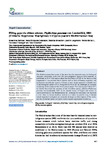Filling gaps via citizen science: Phyllorhiza punctata von Lendenfeld, 1884 (Cnidaria: Scyphozoa: Mastigiidae) in Cyprus (eastern Mediterranean Sea)
| dc.contributor.author | Kaminas, A | en |
| dc.contributor.author | Shokouros-Oskarsson, M | en |
| dc.contributor.author | Minasidis, V | en |
| dc.contributor.author | Langeneck, J | en |
| dc.contributor.author | Kleitou, P | en |
| dc.contributor.author | Tiralongo, F | en |
| dc.contributor.author | Crocetta, F | en |
| dc.date.accessioned | 2022-11-01T09:34:50Z | |
| dc.date.available | 2022-11-01T09:34:50Z | |
| dc.date.issued | 2022-09-01 | en |
| dc.identifier.uri | http://hdl.handle.net/10026.1/19806 | |
| dc.description.abstract |
The Mediterranean Sea is one of the most heavily impacted areas by biological invasions worldwide, with over 650 non-indigenous species (NIS) reported as established in 2019. Information about the distribution of NIS in the basin is often fragmented or non-existent due to factors such as lack of finance, expertise, and appropriate surveillance systems. Citizen science might represent a reliable tool in monitoring the spread of NIS, being able to overcome the challenges of scientific monitoring. In the context of the citizen science project “Is it alien to you? Share it!!!”, we hereby first report the presence of the Australian spotted jellyfish Phyllorhiza punctata von Lendenfeld, 1884 in the marine waters of Cyprus and review its known distribution in the Mediterranean Sea. Although this taxon does not represent a direct threat to human health or tourism as it bears no painful sting, it already caused important ecological and economic damages in other regions of the world, and thus its further spread in Cypriot waters requires appropriate monitoring. | en |
| dc.format.extent | 667 - 675 | en |
| dc.language.iso | en | en |
| dc.title | Filling gaps via citizen science: Phyllorhiza punctata von Lendenfeld, 1884 (Cnidaria: Scyphozoa: Mastigiidae) in Cyprus (eastern Mediterranean Sea) | en |
| dc.type | Journal Article | |
| plymouth.issue | 3 | en |
| plymouth.volume | 11 | en |
| plymouth.publication-status | Published | en |
| plymouth.journal | BioInvasions Records | en |
| dc.identifier.doi | 10.3391/bir.2022.11.3.09 | en |
| plymouth.organisational-group | /Plymouth | |
| plymouth.organisational-group | /Plymouth/Faculty of Science and Engineering | |
| plymouth.organisational-group | /Plymouth/Faculty of Science and Engineering/School of Biological and Marine Sciences | |
| plymouth.organisational-group | /Plymouth/Users by role | |
| plymouth.organisational-group | /Plymouth/Users by role/Academics | |
| dc.identifier.eissn | 2242-1300 | en |
| dc.rights.embargoperiod | Not known | en |
| rioxxterms.versionofrecord | 10.3391/bir.2022.11.3.09 | en |
| rioxxterms.licenseref.uri | http://www.rioxx.net/licenses/all-rights-reserved | en |
| rioxxterms.type | Journal Article/Review | en |


